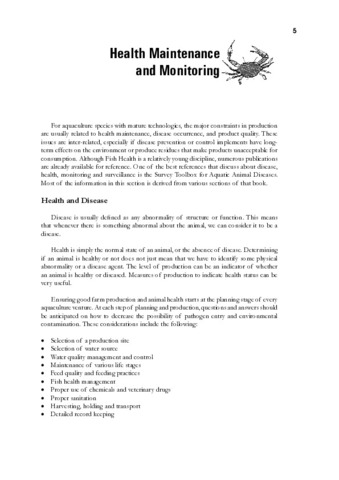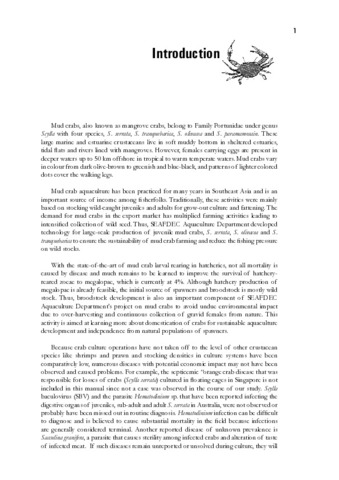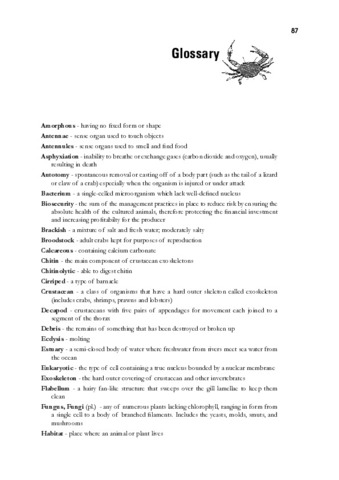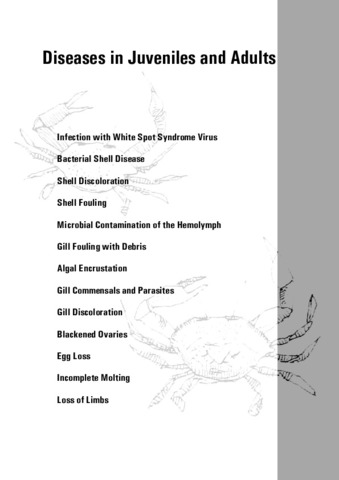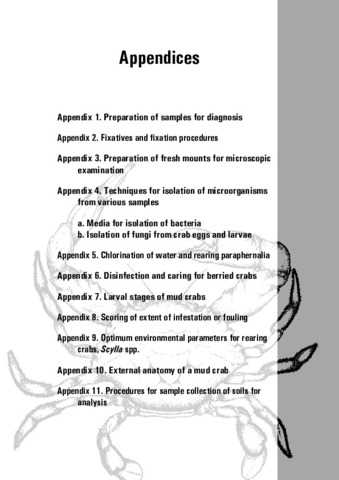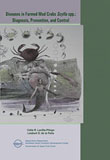Diseases in Farmed Mud Crabs Scylla spp.: Diagnosis, Prevention, and Control
Browse by
Aquaculture production has suffered many set-backs due to the occurrence of diseases. Many of the diseases are caused by infectious organisms that are difficult to detect and need sophisticated instruments for diagnosis, but most disease occurrence and mortality in farmed aquatic animals are related to poor rearing water quality. It is, therefore, important for technicians and farmers to recognize the relationship between the animals they culture and the aquatic environment. The Government of Japan, through the Regional Fish Disease Project, funded research on diseases affecting mud crabs in order to come up with sound prevention and control methods.
This book is a collection of observations gathered from various research and commercial culture activities, and gives emphasis on disease recognition using simple techniques and gross observations of affected crabs. However, since many of the diseases are caused by microorganisms, microscopy is an important technique for their diagnosis. The authors of the book encourage active cooperation between farmers and diagnostic laboratories for disease identification, prevention, and control in order to build up more information to increase production. The Regional Fish Disease Project supports sustainable mud crab production and hopes that farmers and other users of this book will attain their production goals.
Contents
- Foreword
- Message
- Acknowledments
- Introduction
- Health maintenance and monitoring
- Diseases in eggs and larvae
- Diseases in juveniles and adults
- Appendices
- Glossary
Acknowledgments
We thank the Government of Japan (GOJ) through the Regional Fish Disease Trust Fund for funding the publication of this book. The Project Leaders, Dr. Y. Inui and Dr. K. Nagasawa, provided the necessary push to finish the book on time. Information contained herein are results of studies on mud crab funded by the SEAFDEC Aquaculture Department, GOJ Regional Fish Disease Project, and the Culture and Management of Scylla spp. Project funded by the European Commission (INCO-CAMS).
For the duration of the studies, valuable technical assistance was provided by Demy D. Catedral, Sharon Ann G. Pedrajas-Mendoza, and Helen Marcial. We also acknowledge colleagues in the Mud Crab Team composed of Emilia T. Quinitio, Fe Dolores Parado-Estepa, Jurgenne H. Primavera, and Eduard M. Rodriguez. Remia Traviña and Milagros G. Paner of Fish Health Section's Diagnostic Services Laboratory, as well as Susan Torrento and Fely Torreta of the Microtechnique Laboratory, extended valuable help in processing specimens. Several specimens that were studied came from farmers who submitted their samples for analysis at the Diagnostic Services Laboratory – our sincerest thanks to the farmers.
We thank Dr. Emilia T. Quinitio for providing photos of larval stages of mud crab that are in Appendix 7 and for giving us valuable comments to improve the book. Dr. Teodora U. Bagarinao and Dr. Kazuya Nagasawa thoroughly reviewed the draft and gave important suggestions that improved the lay-out, format, and presentation of contents. We recognize the artistic talent Raph Nacepo, who patiently did the lay-out.
Our heartfelt thanks to Mr. Hermes Alegre, one of the Philippines' best selling visual artists, for his rendition of "Crab Circle of Life”. Notwithstanding the fact that we have not met, he created and entrusted to us his original artwork to cover this manual. Portions of this artwork are also used to highlight section separators.
Celia R. Lavilla-Pitogo and Leobert D. de la Peña
December 2004
Recent Submissions
-
Health maintenance and monitoring.
(Aquaculture Department, Southeast Asian Fisheries Development Center, 2004)For aquaculture species with mature technologies, the major constraints in production are usually related to health maintenance, disease occurrence, and product quality. These issues are inter-related, especially if disease ... -
Introduction: Diseases in farmed mud crabs Scylla spp. : diagnosis, prevention, and control.
(Aquaculture Department, Southeast Asian Fisheries Development Center, 2004) -
Glossary: Diseases in farmed mud crabs Scylla spp.
(Aquaculture Department, Southeast Asian Fisheries Development Center, 2004) -
Diseases in eggs and larvae
(Aquaculture Department, Southeast Asian Fisheries Development Center, 2004) -
Diseases in juveniles and adults.
(Aquaculture Department, Southeast Asian Fisheries Development Center, 2004) -
Appendices: Diseases in farmed mud crabs Scylla spp.
(Aquaculture Department, Southeast Asian Fisheries Development Center, 2004) -
Diseases in farmed mud crabs Scylla spp.: Diagnosis, prevention, and control.
(Aquaculture Dept., Southeast Asian Fisheries Development Center, 2004-12)Aquaculture production has suffered many set-backs due to the occurrence of diseases. Many of the diseases are caused by infectious organisms that are difficult to detect and need sophisticated instruments for diagnosis, ...

